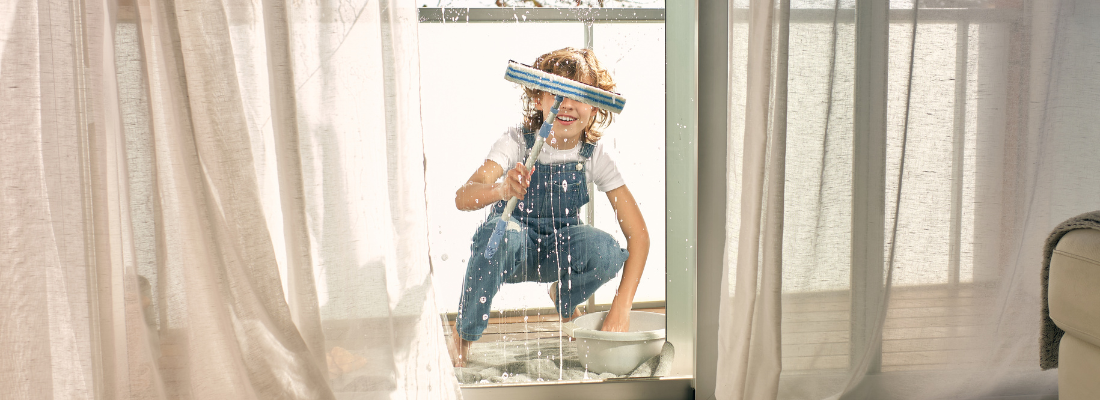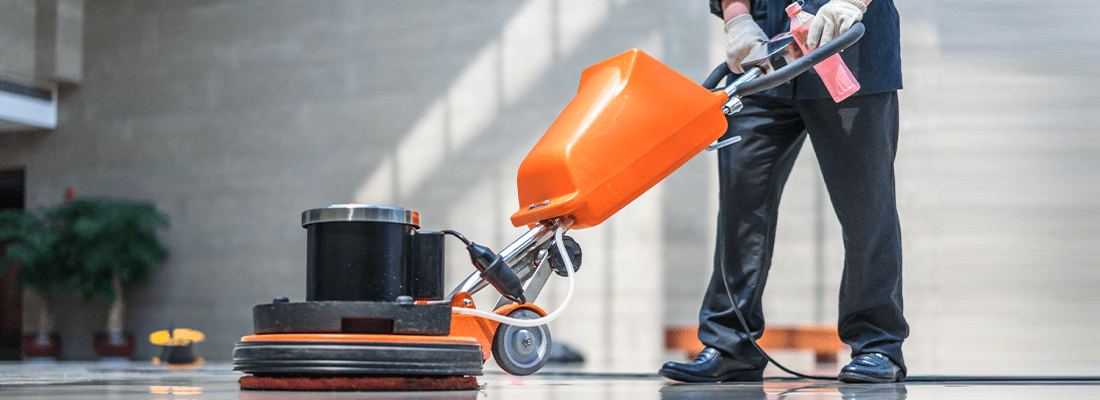The use of cleaning equipment has evolved over the years. Tools were replaced by robots, and technology is now a priority in the cleaning industry. These developments resulted in several inventions that have become an essential part of commercial cleaning.
Commercial properties call for specialised cleaning equipment in order to quickly and efficiently clean large spaces. With numerous types of cleaning equipment in the market, it is usually hard to know what to choose. This article looks at some of the common types of commercial cleaning tools along with their benefits, as well as the storage and maintenance of different types of cleaning equipment.
What is cleaning equipment and what are their uses?
The term ‘cleaning equipment’ is very broad. There are many different types of equipment, like pressure cleaners, sweepers and polishers, but also vacuum cleaners. It is important to choose the right equipment for a certain cleaning job. Pressure cleaners are machines that use high-powered steam to get rid of stains and dirt. They are especially ideal for cleaning concrete regions such as walls, patios, and walkways. They can ideally be used to clean cars, lorries, and caravans. Pressure cleaners come in various shapes and sizes. They are additionally ideal for degreasing commercial kitchens. The next essential tool for commercial cleaning are sweepers. These are large machines with a rotatory sweeping head located underneath the front of the machine. A sweeper is controlled by a driver who sits on a commercial sweeper and use a driving wheel to steer the device. These are especially useful for cleaning vast outdoor areas like the pavement outside a huge commercial place or on roads. A carpet cleaner is another essential. These cleaners have the ability to remove stubborn stains from almost any carpet area. They are quite essential when it comes to cleaning as they are one of the best devices to remove hard to budge stains without the need to replace the carpets.
Scrubbers are designed to clean stains from hard floored regions. They are ideal for use in huge commercial buildings that have wood or marble flooring. They come in either sit on form or handheld form. The type to choose depends on the size of the region you need to clean.
A polisher is another essential equipment when it comes to commercial cleaning. A polisher is able to turn a dirty hard floor it a brand new in a timely fashion. Polishers are usually used in institutions such as universities, schools, museums and hospitals. Sit-on polishers are perfect for larger spaces while handheld polishers are used on relatively small areas.
As we all know, a vacuum cleaner removes dust and dirt from both carpeted and hard floors. Commercial vacuum cleaners are usually more powerful than household vacuum cleaners. They are ideally packed with numerous features that allow you to reach and clean unreachable areas. There’s also wet vacuum cleaners that are used to suck up water. Others come with a dry and wet function to allow you to switch between your preferred modes easily.
How cleaning equipment should be cleaned and stored
Facility managers are always looking for ways to save money. One way to potentially cut expenses is to better maintain and even perform light repairs on the cleaning equipment they use every day—specifically, vacuum cleaners and automatic floor machines.
Firstly, floor machines like scrubbers and polishers. For the most part, these are very durable machines, although the motor may need to be replaced after a few years of service. This is a complicated process and should only be done by a professional. As soon as a motor-related problem is detected, stop using the machine. It’s when we are working with more sophisticated machines, such as automatic scrubbers, that repair and maintenance becomes more complicated. One of the big concerns with floor machines has little to do with the mechanicals, but involves the squeegees found on the back of the machine.
During the operation, the squeegees help gather and remove moisture, along with soil, lint, hair, and other debris. Some of this debris can rip or tear the squeegees, affecting the performance of the machine and the appearance of the floors. Dirty, torn, or uneven squeegees can produce streaks and lines on a clean floor.
Avoid these problems by frequently checking the squeegees and replacing them as needed. With the development of world-class floor machines, which are more service-friendly for users, accessing and changing the squeegees has become easier. Next, check behind the floor machine’s pads or, if the machine contains a cylindrical brush technology, its cylinders. These areas can be magnets for debris that can affect the machine’s performance. Just remove the debris from the brushes to minimise further maintenance problems.
Regular lubrication also keeps floor machines running smoothly. Schedule oil and lubrication applications to the machine joints. Lubrication is a task that users may be able to perform on their own depending on the machine and model.
Vacuum cleaner should also not be overlooked when maintaining cleaning equipment. One of the easiest ways to keep a vacuum cleaner up and running is to simply change the bag. As the bag fills, the machine becomes less effective and slows down the motor. The bag should be changed every day if the machine is used more than a few hours per day. Likewise, regularly clean the filters. Almost all high-end machines, as well as many of the new generation of vacuum cleaners, require the filters to be maintained on a regular basis for the vacuum to be effective and high performing.
Unless you have a wet/dry vac, you should not be vacuuming up liquid. Once moisture is absorbed into the machine, a variety of components, from motors to hoses, can be harmed. Moisture causes dirt and dust to cling to the sides of hoses, limiting the machine’s performance. It can also cause odour problems, which can negatively impact the machine and the indoor environment. Always be aware of what you are picking up with your vacuum. Coins, paper clips, and other items can get stuck in the machine, cause a strain on the motor, or damage belts.
Listen for your vacuum getting louder, which is a signal that moisture or a foreign object are inside the machine. Or it can be a sign of motor wear, with more serious problems soon to come. If you notice your vacuum has become louder, stop, access what is user-accessible, and see if the problem can be detected and corrected in-house. If not, a service call may be required. Don’t forget to regularly check and clean the beater bar. If it is covered with lint and debris, the machine cannot adequately perform and vacuuming efficiency will be negatively affected.
An often overlooked item is the user manual. This contains important information about how to use and maintain equipment in the best way possible, and could be worth the 15 minute read. Most manufacturers know their equipment well and can predict which parts may break down and advise whether they can be fixed by the user or require a service professional. When problems develop, a review of the troubleshooting guide can help explain what is happening, why it is happening, and what you should do about it. Usually, cleaning professionals are focused more on cleaning than on the care of the equipment they use. As a result, floor machines and vacuums can really be put through some challenges.
Instructing users to show more care for the machines, inspecting them regularly, and taking action at the first sign that a problem may be developing can prevent downtime, cut repair bills, and add years of useful life to the equipment.
Cleaning equipment used in hotels
Now that we have got a clear image of what cleaning equipment is and how you are supposed to use and maintain it, let’s talk about the most common cleaning equipment used in hotels. The equipment used in housekeeping is often similar to the equipment used in hotels.
Wet Extractors
These machines are used to restore the surface appearance of carpets, upholstery and curtains. They remove the more deeply embedded soil which is normally not easily removed by suction cleaning. They are also useful in the application of soil-retardant finishes on carpets.
Hot-water extraction machines
These are machines with no rotary action and carry a tank for hot water and detergent, which are used for deep cleaning carpets. The hot water and detergent are sprayed into the carpet by high-pressure spray nozzles. The dirt is flushed to the surface and this, along with the soiled water is removed by suction into a container in the machine. Hot water extractors should never be filled with water that is higher than 66°C or 150°F in temperature, this is because wool carpets shrink at high temperatures.
Solvent extraction machines
These machines are primarily used for cleaning upholstery and curtains.
Wet Vacuums
Wet vacuums are used to pick up spills or to pick up the water that is used during carpet or floor cleaning. Many wet vacuums can also be used on floors to pick up dry soils.
Rotary Floor Machines
Rotary floor machines can be used for a wide variety of surface cleaning jobs. For carpets, these machines can be fitted with pads or brushes to perform dry-foam cleaning. On hard surface floors, rotary floor machines can be used for polishing and scrubbing.
How to clean equipment used in pharmaceuticals
Cleaning pharmaceutical processing equipment is challenging. Cleaning methods, soils present, type of manufacturing equipment, surfaces cleaned, choice of cleaning detergent and temperature should all be considered when cleaning the equipment. Here is some advice on how to clean different types of equipment used in pharmaceuticals.
Soils found on pharmaceutical processing equipment may be traces of the various ingredients used in production or soils from the actual manufacturing process such as oil, grease, dust or minerals. Understanding the soils that are present will help you choose the right cleaning detergent. Each type of soil is unique and requires the proper detergent to thoroughly clean the surface. Choose a cleaner that will best attack the soils you are trying to remove. Alkaline cleaners are the best choice for cleaning soils such as gels, dyes and petrolatum, while citric acid based cleaners are better suited for removing titanium dioxide. Protein or starch-based soils may require the use of an enzyme cleaner.
Another important factor to take into account is how the equipment is used. Are you cleaning a dedicated production system or equipment that is used to produce a range of products? Equipment used to produce multiple products has a greater chance of cross contamination of ingredients. It is also important to select a cleaner that is compatible with the surface of the equipment you are cleaning. The cleaner manufacturer should be able to help you and provide useful information about their products.
In most cases, increasing the temperature is one of the best ways to speed up or improve the cleaning action. The temperature parameters that should be used for any individual cleaning application will depend upon the equipment and the soils that are present, as well as your choice of detergent and wash method. Check with the manufacturer for the maximum suggested operating temperature for your detergent. The length of the cleaning process contributes to the effectiveness. In most cases, a longer dwell time will improve the results. However, all factors - soils, temperature, substrate, detergent and cleaning method - should be considered. Finally, rinsing removes any excess detergent left on the item. For critical cleaning applications, it is best to use deionised or distilled water, as rinsing with ordinary water could cause new contaminants.
Why is cleaning equipment colour coded?
Colour coded cleaning is the process of designating colours to cleaning equipment in certain areas of a venue, reducing the spread of germs across areas and increasing hygiene throughout a business or home. The four main colours used and to separate out areas such as bars, public areas, kitchen & food preparation areas and washrooms, are red, blue, green and yellow.
Colour coding is used throughout a variety of industries and trades where health and safety is paramount, in particular catering and healthcare as cross contamination will lead to illness. The cleaning equipment colours are representative to their area of use. For example, you would not want to clean the floors of a kitchen with a mop that has been previously used to clean the bathroom floors. Colour coding can be broken down into 4 areas:
- Public areas such as lobbies, receptions and hallways
- Washroom and toilets – this can include shower rooms and bathrooms
- Restaurant and bar – including dining areas and cafe lounge spaces
-
Kitchen and food preparation areas – any kitchen, food station or area where food is kept and/or prepared
For this system to work, you will need to assign different cleaning equipment to each area, with a coloured handle, head or bristles to make it easily identifiable. This hygienic cleaning system can be applied to any cleaning equipment that is used in a certain area.
Keep up with the latest innovations
Driven by the opportunities that new technologies bring; great things are already happening in the industry. Sign up for the Interclean newsletter and be the first to know about the newest industry developments.
Subscribe to newsletter







